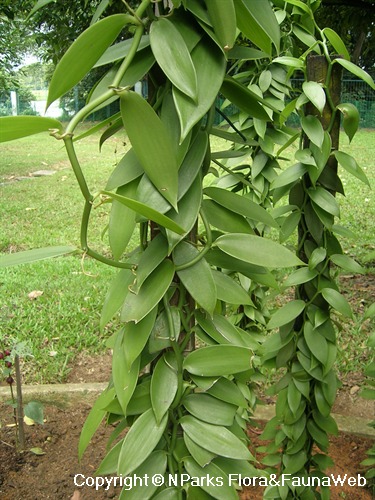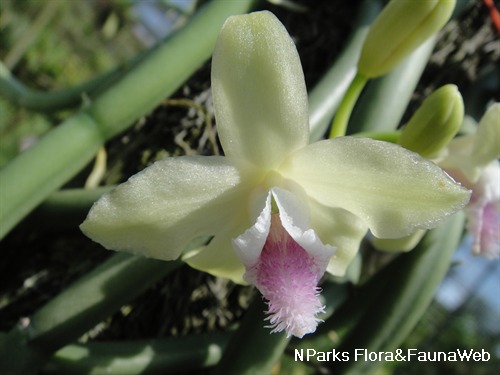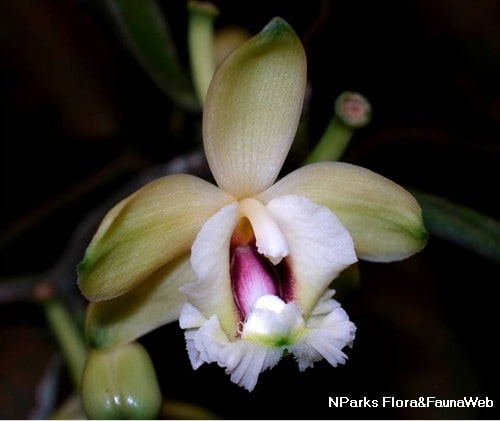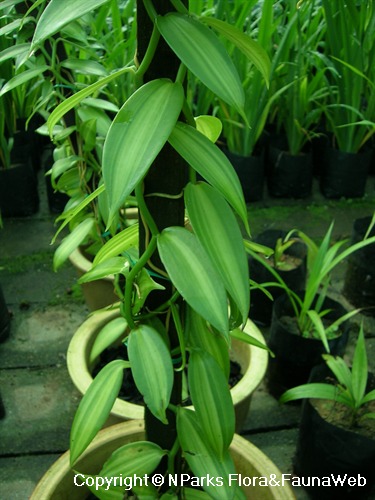
Back
Vanilla planifolia Andrews
| Family Name: | Orchidaceae |
| Synonyms: | Vanilla sylvestris, Vanilla tiarei, Mokara fragrans, Vanilla duckei, Vanilla sativa, Vanilla viridiflora, Notylia planifolia, Vanilla planifolia var. gigantea, Vanilla hirsuta |
| Common Name: | Vanilla, Bourbon Vanilla, Common Vanilla, Vanilla Orchid, Vanilla Vine, Commercial Vanilla, 扁叶香草兰 |
Name
Classifications and Characteristics
| Plant Division | Angiosperms (Flowering Seed Plants) (Monocotyledon) |
|---|---|
| Plant Growth Form | Climber, Epiphyte |
| Lifespan (in Singapore) | Perennial |
| Mode of Nutrition | Autotrophic |
Biogeography
| Native Distribution | Mexico, Caribbean, South America |
|---|---|
| Preferred Climate Zone | Tropical |
| CITES Protection | True (Appendix II) |
Description and Ethnobotany
| Growth Form | A herbaceous climber, it climbs by means of its roots and can grow up to 10 to 15m in height. |
|---|---|
| Foliage | The leaves are arranged alternately along the cylindrical stem 1 to 2cm thick. The thick fleshy leaves are sessile and oblong-elliptical to lanceolate in shape. |
| Flowers | The yellow-green flowers are borne on short, axillary infloresences with 1 to 3 flowers open at one time and bloom from the base of the inflorescence upwards. |
| Cultivation | It is best grown in a warm and humid environment, under partial sun in light soil with good drainage. A drier period of 2 months encourages flowering. Heavy rainfall discourages fruit development. |
| Ethnobotanical Uses | Edible Plant Parts : Edible Fruits Food (Herb or Spice) |
Landscaping Features
| Desirable Plant Features | Ornamental Flowers, Ornamental Foliage, Fragrant (Flowers, Fruits) (Time Independent) |
|---|---|
| Landscape Uses | Container Planting, Parks & Gardens, Vertical Greenery / Green Wall |
| Thematic Landscaping | Economic Garden |
| Plant & Rootzone Preference or Tolerance Remarks | It is best grown in light soils with good drainage and enriched with a layer of humus. |
Fauna, Pollination and Dispersal
| Pollination Method(s) | Biotic (Fauna) (Associated with: Pollinated by Euglossine bees., Insects (Bee)) |
|---|---|
| Seed or Spore Dispersal | Abiotic (Explosive Dehiscence) |
Plant Care and Propagation
| Light Preference | Semi-Shade |
|---|---|
| Water Preference | Little Water |
| Plant Growth Rate | Moderate |
| Rootzone Tolerance | Drought Tolerant, Well-Drained Soils |
| Propagation Method | Stem Cutting (Herbaceous) |
Foliar
| Foliage Retention | Evergreen |
|---|---|
| Mature Foliage Colour(s) | Green |
| Mature Foliage Texture(s) | Smooth, Glossy / Shiny, Thick |
| Foliar Type | Simple / Unifoliate |
Floral (Angiosperm)
| Flower & Plant Sexuality | Bisexual Flowers |
| Flower Colour(s) | Green, Yellow / Golden |
|---|---|
| Flower Grouping | Cluster / Inflorescence |
| Flower Location | Axillary |
| Flower Symmetry | Bilateral |
| Flowering Opening Time | Daytime |
| Flower Lifespan on Plant | 1 Day |
| Flowering Habit | Polycarpic |
Fruit, Seed and Spore
| Mature Fruit Colour(s) | Black |
|---|---|
| Fruit Classification | Simple Fruit |
| Fruit Type | Dehiscent Dry Fruit |
Image Repository
Others
| Master ID | 235 |
|---|---|
| Species ID | 1531 |
| Flora Disclaimer | The information in this website has been compiled from reliable sources, such as reference works on medicinal plants. It is not a substitute for medical advice or treatment and NParks does not purport to provide any medical advice. Readers should always consult his/her physician before using or consuming a plant for medicinal purposes. |



